Name: Mizu Designs
Websites
www.mizudesigns.blogspot.com
www.mizudesigns.com.au
www.flickr.com/photos/kyliebudge/
Brief Bio
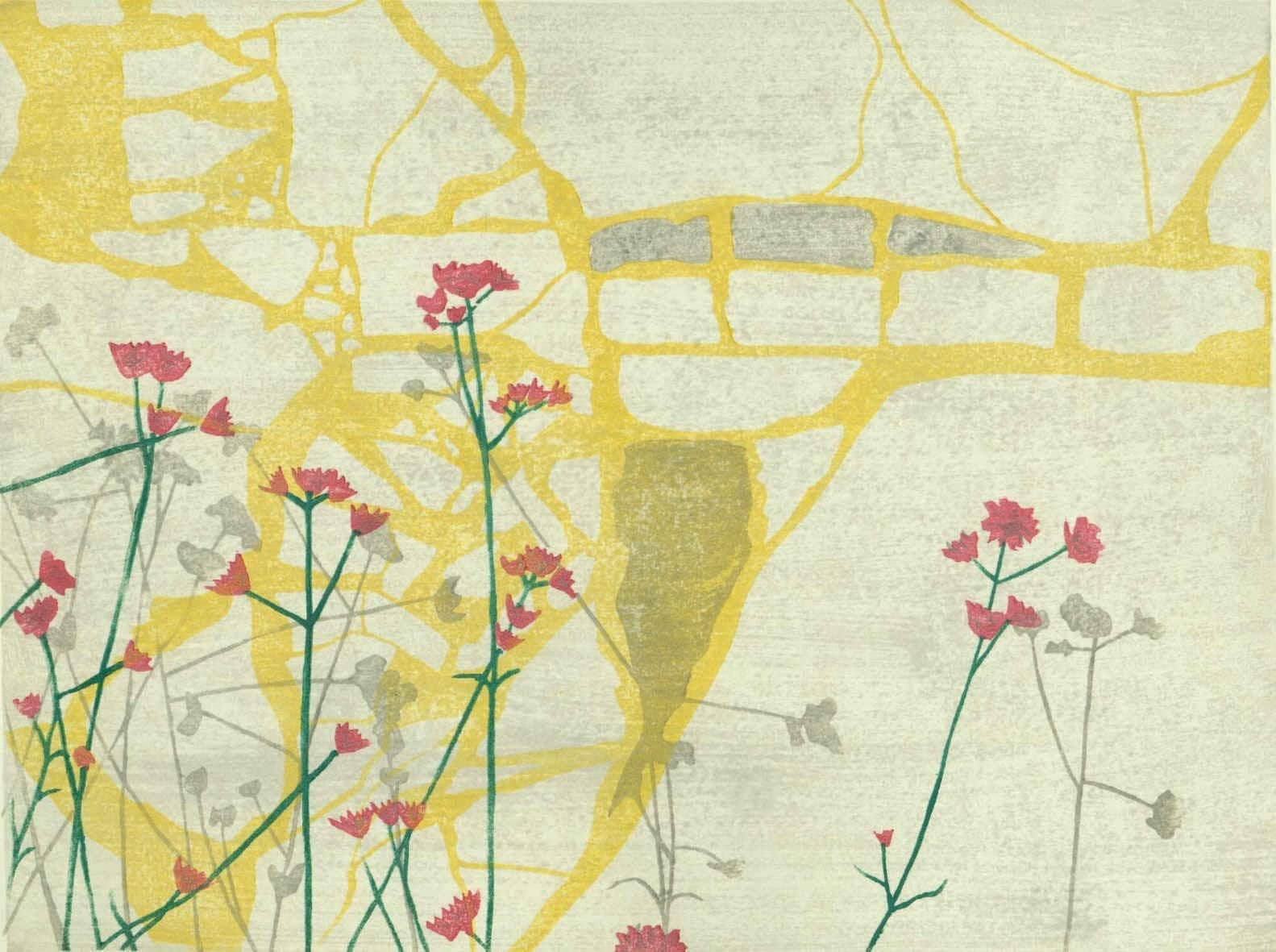 I’ve been making woodblock prints since 1998 when I moved to Japan. I’d dabbled in screen printing in high school and also some lino block printing but was really struck by the beauty of woodblock prints in the Japanese moku hanga tradition. I badgered a Japanese printmaker in Kyoto to take me on as her student and she taught me the moku hanga tradition and took me to galleries and introduced me to many artists who I would never had met and seen if it had not been for her. I’ve been printmaking ever since.
I’ve been making woodblock prints since 1998 when I moved to Japan. I’d dabbled in screen printing in high school and also some lino block printing but was really struck by the beauty of woodblock prints in the Japanese moku hanga tradition. I badgered a Japanese printmaker in Kyoto to take me on as her student and she taught me the moku hanga tradition and took me to galleries and introduced me to many artists who I would never had met and seen if it had not been for her. I’ve been printmaking ever since.What printmaking medium do you most often work in?
I usually make relief prints and most often in the Japanese woodblock printmaking tradition. I also enjoy making lino prints and have been making more of those recently. I’d like to do some more silk screen printing in the future but must say that I prefer the texture of relief printing.
There’s a 3D type element to it that you can’t really get with silk screen printing and I think that’s what I really like about it.
How did you get started in printmaking? I notice from your profile that you've studied printmaking in Japan. How did this come about and can you tell a bit about that experience?
Printmaking for me is very deeply connected to my seven lovely years living in Kyoto, Japan. Every art gallery and museum there is stuffed to the gills
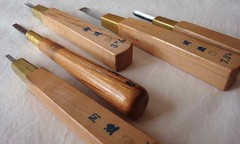 with ancient ukiyo-e prints that it’s hard not to notice printmaking when you’re there. I love looking at the intricate carving work of prints by people like Utamaro.
with ancient ukiyo-e prints that it’s hard not to notice printmaking when you’re there. I love looking at the intricate carving work of prints by people like Utamaro.The ukiyo-e period of printmaking in Japan produced some astounding works. I soaked all of that up while I was there and really had so much inspiration around me that it’s not surprising that I was drawn to printmaking. Studying printmaking in a beautiful old city like Kyoto, that values traditional art forms, was a pleasure. The city is full of washi (paper) shops. It was easy to get my hands on rolls and rolls of beautiful hand made paper. I was spoilt for choice. And traditional carving tools and brushes as well as the baren (a flat, round disc covered in a bamboo leaf used for printing) are easy to come by as are lovely prepared pieces of shina ply for carving. Sumi, the traditional black ink, was also easily available. I was forever riding around the city on my bicycle picking up paper and other supplies for printmaking. It was so much fun to find new little paper shops tucked away in corners of the city and buy washi to take home to experiment with.
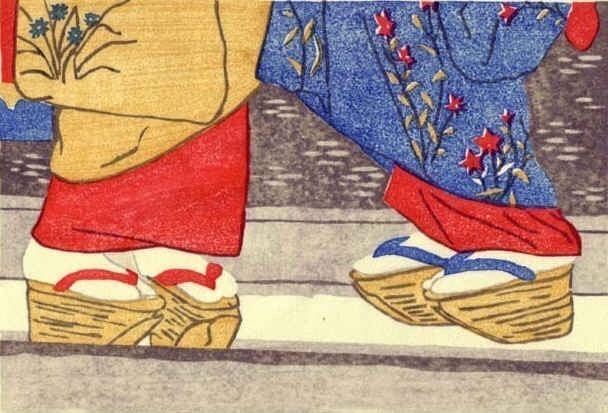 I was even lucky enough to visit a still functioning but very traditional printmaking studio in Kyoto where the master printmaker works in a tiny room sitting on the floor surrounded by his 4 apprentice printmakers. There is barely enough room for each of them to sit cross legged at their tables while they print but they all work extremely productively and harmoniously in that tiny space. I was amazed at their skill level. They were able to press the paper with their baren and print off a perfect image in a matter of seconds. Piles of completed prints (hundreds and hundreds) were stacked neatly beside each printer. Experiences like this made me even more
I was even lucky enough to visit a still functioning but very traditional printmaking studio in Kyoto where the master printmaker works in a tiny room sitting on the floor surrounded by his 4 apprentice printmakers. There is barely enough room for each of them to sit cross legged at their tables while they print but they all work extremely productively and harmoniously in that tiny space. I was amazed at their skill level. They were able to press the paper with their baren and print off a perfect image in a matter of seconds. Piles of completed prints (hundreds and hundreds) were stacked neatly beside each printer. Experiences like this made me even moredetermined to design and produce prints.
Describe where you work.
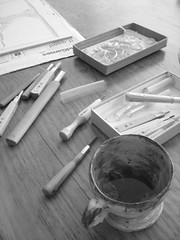 Japanese style printmaking is small and portable which is a good thing if you don’t have much space. I work from home in a studio that’s part of my house. For the moment this suits me fine but sometimes I think it would be lovely to work in a more communal studio space with other artists.
Japanese style printmaking is small and portable which is a good thing if you don’t have much space. I work from home in a studio that’s part of my house. For the moment this suits me fine but sometimes I think it would be lovely to work in a more communal studio space with other artists.What's your creative process for any given print? (eg. sketch first? Pre-planned or free-form?)
I usually start off with and an idea and then sketch it out a bit on paper to think about the layers and colours I might use to help me plan out my blocks. In Japan I was taught to do this very carefully and precisely but I’m a bit looser about it these days. Then I carve my blocks until I’m happy. This part can take a very long time. With printing I sometimes do a practice print to see if the colours are working together and if the blocks have been carved well enough, especially with a design involving the alignment of 5 or more blocks. In Japan I saw people printing designs with 20-30 blocks all aligned. I’m not sure I have the stamina or patience for that kind of work!
What do you enjoy most about printmaking?
I love seeing the finished print! That’s probably how most printmakers feel about things because the process of getting to that point can take a very long time and often it’s not until you actually print that you can really tell if an idea has come together well or not.
What's your least favorite part of the process?
Sometimes carving the blocks can take a very long time especially if it’s a particularly complex print. If it takes too long I can lose interest in the print and have to take a break to work on something else and come back to it later. Sometimes that’s ok, but other times I might have creatively moved on from the design and not want to finish carving at all!
What are your inspirations (other artists, people, places, events, etc.)?
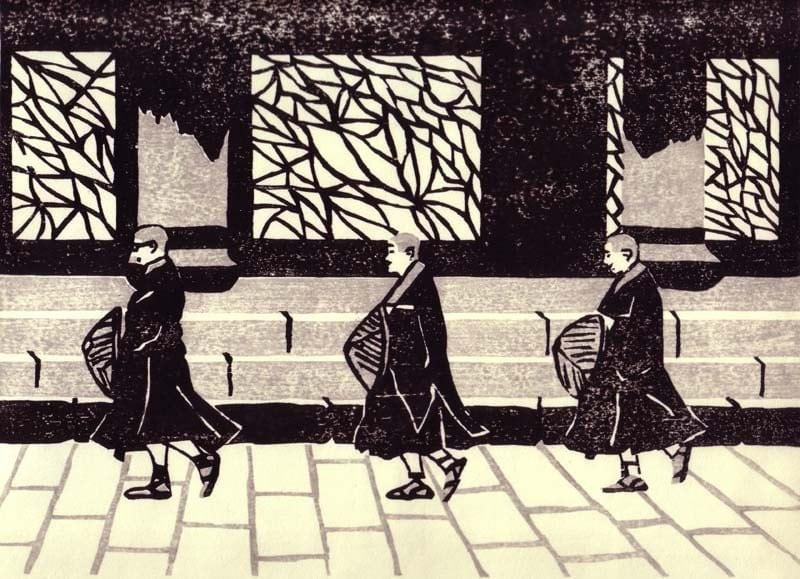 I’m inspired by simple things like going for a walk down at the creek near my house, or going for a bike ride on a sunny day. I love going to exhibitions of artists who produce works on paper and wish there were more on offer. I like to see what people are making, what techniques they’re trying, the colours they’re using, that kind of thing. I love looking at what people are doing on flickr. It can be so inspiring and it’s a way to see a range of art from many different countries. Japan continues to inspire me even though I no longer live there. I also love incorporating tea and the
I’m inspired by simple things like going for a walk down at the creek near my house, or going for a bike ride on a sunny day. I love going to exhibitions of artists who produce works on paper and wish there were more on offer. I like to see what people are making, what techniques they’re trying, the colours they’re using, that kind of thing. I love looking at what people are doing on flickr. It can be so inspiring and it’s a way to see a range of art from many different countries. Japan continues to inspire me even though I no longer live there. I also love incorporating tea and theritual of drinking it into my illustrations in one way or other. And indigenous Australian plant life is continually fascinating to me.
How has your work changed and evolved since you started?
When I first started printmaking in Japan I was very focused on technique and understanding it well and so I was very tight in the way I worked. I think I have learned to loosen up a little since then and am not so concerned about doing things ‘the right way’ any more if it gets in the way of exploring an idea or experimenting with process to discover a new image. I admire people who can work loosely and still make beautiful prints. I’d like to learn from them and be a bit braver.
How do you get past creative slumps?
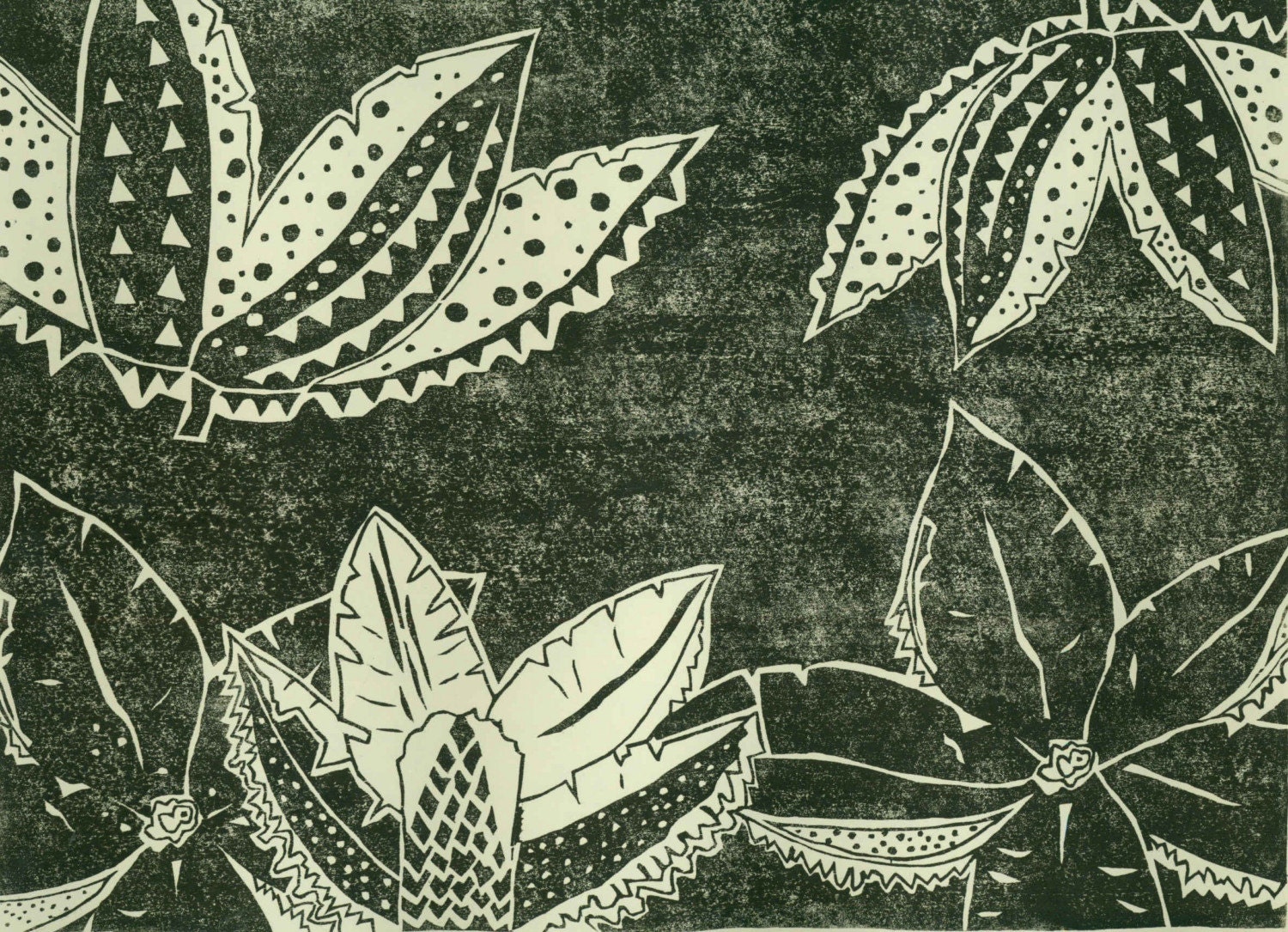 Sometimes it’s good to take a break from printmaking because it’s not possible to feel creative all the time. I recently had a 3 week holiday in New York and it was amazing for recharging my energy and inspiring me in a creative sense because I spent a lot of time in galleries and museums. Sometimes all we need is to step away from the every day for a while, breathe a little, and the creative slumps can just melt away.
Sometimes it’s good to take a break from printmaking because it’s not possible to feel creative all the time. I recently had a 3 week holiday in New York and it was amazing for recharging my energy and inspiring me in a creative sense because I spent a lot of time in galleries and museums. Sometimes all we need is to step away from the every day for a while, breathe a little, and the creative slumps can just melt away.How do you promote your work?
I have an etsy shop where I sell my work and like to blog as well but apart from that I do very little promotion. I exhibited my work in Japan but haven’t done that in Australia since returning in 2005. I’ve just put together my very first website so I’m quite excited about that. My friends
do a lot of word of mouth promotion for me, which I think is really very sweet.
Any other comments or advice for others who want to try making hand-pulled prints?
My advice to someone starting out is don’t be afraid to give many different types of printmaking a try. It may take a while for you to discover a form that you like more or feel more comfortable working with. Or you might find you like them all! Also, if you want to work in the Japanese
woodblock printing tradition be prepared for the physicality of it – it can be quite hard work especially if you’re printing on a hot day. Personally I like that about it. It makes me feel like I’ve really worked at something to get to the end point.
5 comments:
Great work, Kylie. I have not seen many woodblock prints, but these are very striking. It looks like you do a great deal with them. I love the variety you have shown with this medium.
Congratulations on your new web site, Kylie! It looks great and it's wonderful to see all your moku hanga prints together in one place. I enjoyed hearing about your time spent in Kyoto (jealous!!) and I identified with a lot of the things you mentioned -- trying to work in a looser way, loving the materials, the difficulty of being patient when carving a complicated block. I've also never heard anyone talk about the sheer physicality of printing moku-hanga style -- I thought it was just me and my weak arms. Printing is such a work-out!
Thanks to both you for your sweet words! Annie - I find printing in the moku hanga style so full-on physically. My teacher in Japan use to laugh at me when I commented on it. I think she thought I was a bit of a wimp. But it is very physical! When it's a warm day and I'm moving that baren across my paper and block the sweat just rolls off me!!!
Your work is really lovely. Your description of living in Kyoto, with access to washi, other supplies and teachers is so romantic. I didn't try moku hanga until a couple years after I'd lived in Tokyo - but I must say I was sore for a week after carving a large four block print. :)
-minouette
Thank you for this site which I just found. It is very useful and informative.
http://www.silkscreennow.com/
Post a Comment